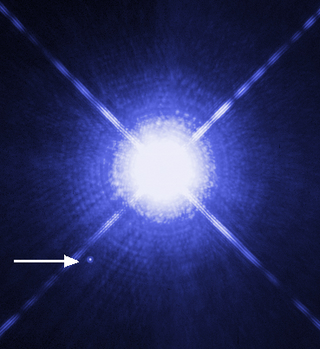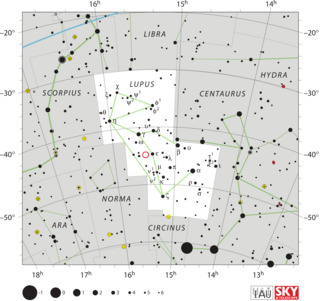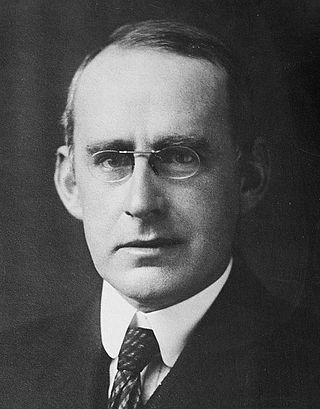The Chandrasekhar limit is the maximum mass of a stable white dwarf star. The currently accepted value of the Chandrasekhar limit is about 1.4 M☉ (2.765×1030 kg). The limit was named after Subrahmanyan Chandrasekhar.

Stellar evolution is the process by which a star changes over the course of its lifetime and how it can lead to the creation of a new star. Depending on the mass of the star, its lifetime can range from a few million years for the most massive to trillions of years for the least massive, which is considerably longer than the current age of the universe. The table shows the lifetimes of stars as a function of their masses. All stars are formed from collapsing clouds of gas and dust, often called nebulae or molecular clouds. Over the course of millions of years, these protostars settle down into a state of equilibrium, becoming what is known as a main-sequence star.

A white dwarf is a stellar core remnant composed mostly of electron-degenerate matter. A white dwarf is very dense: its mass is comparable to the Sun's, while its volume is comparable to Earth's. A white dwarf's low luminosity comes from the emission of residual thermal energy; no fusion takes place in a white dwarf. The nearest known white dwarf is Sirius B, at 8.6 light years, the smaller component of the Sirius binary star. There are currently thought to be eight white dwarfs among the hundred star systems nearest the Sun. The unusual faintness of white dwarfs was first recognized in 1910. The name white dwarf was coined by Willem Jacob Luyten in 1922.
Degenerate matter occurs when the Pauli exclusion principle significantly alters a state of matter at low temperature. The term is used in astrophysics to refer to dense stellar objects such as white dwarfs and neutron stars, where thermal pressure alone is not enough to avoid gravitational collapse. The term also applies to metals in the Fermi gas approximation.

Subrahmanyan Chandrasekhar was an Indian-American theoretical physicist who made significant contributions to the scientific knowledge about the structure of stars, stellar evolution and black holes. He was awarded the 1983 Nobel Prize in physics along with William A. Fowler for "...theoretical studies of the physical processes of importance to the structure and evolution of the stars". His mathematical treatment of stellar evolution yielded many of the current theoretical models of the later evolutionary stages of massive stars and black holes. Many concepts, institutions and inventions, including the Chandrasekhar limit and the Chandra X-Ray Observatory, are named after him.

In astronomy, cataclysmic variable stars (CVs) are stars which irregularly increase in brightness by a large factor, then drop back down to a quiescent state. They were initially called novae, since ones with an outburst brightness visible to the naked eye and an invisible quiescent brightness appeared as new stars in the sky.
In astronomy, the term compact object refers collectively to white dwarfs, neutron stars, and black holes. It could also include exotic stars if such hypothetical, dense bodies are confirmed to exist. All compact objects have a high mass relative to their radius, giving them a very high density, compared to ordinary atomic matter.
In astrophysics and condensed matter physics, electron degeneracy pressure is a quantum mechanical effect critical to understanding the stability of white dwarf stars and metal solids. It is a manifestation of the more general phenomenon of quantum degeneracy pressure.

In astrophysics, a polytrope refers to a solution of the Lane–Emden equation in which the pressure depends upon the density in the form

A Type Ia supernova is a type of supernova that occurs in binary systems in which one of the stars is a white dwarf. The other star can be anything from a giant star to an even smaller white dwarf.

In general relativity, post-Newtonian expansions are used for finding an approximate solution of Einstein field equations for the metric tensor. The approximations are expanded in small parameters that express orders of deviations from Newton's law of universal gravitation. This allows approximations to Einstein's equations to be made in the case of weak fields. Higher-order terms can be added to increase accuracy, but for strong fields sometimes it is preferable to solve the complete equations numerically. This method is a common mark of effective field theories. In the limit, when the small parameters are equal to 0, the post-Newtonian expansion reduces to Newton's law of gravity.
Carbon detonation or carbon deflagration is the violent reignition of thermonuclear fusion in a white dwarf star that was previously slowly cooling. It involves a runaway thermonuclear process which spreads through the white dwarf in a matter of seconds, producing a type Ia supernova which releases an immense amount of energy as the star is blown apart. The carbon detonation/deflagration process leads to a supernova by a different route than the better known type II (core-collapse) supernova.
Edmund Clifton Stoner FRS was a British theoretical physicist. He is principally known for his work on the origin and nature of itinerant ferromagnetism, including the collective electron theory of ferromagnetism and the Stoner criterion for ferromagnetism. Stoner made significant contributions to the electron configurations in the periodic table.
The magnetorotational instability (MRI) is a fluid instability that causes an accretion disk orbiting a massive central object to become turbulent. It arises when the angular velocity of a conducting fluid in a magnetic field decreases as the distance from the rotation center increases. It is also known as the Velikhov–Chandrasekhar instability or Balbus–Hawley instability in the literature, not to be confused with the electrothermal Velikhov instability. The MRI is of particular relevance in astrophysics where it is an important part of the dynamics in accretion disks.

KPD 1930+2752 is a binary star system including a subdwarf B star and a probable white dwarf with relatively high mass. Due to the nature of this astronomical system, it seems like a likely candidate for a potential type Ia supernova, a type of supernova which occurs when a white dwarf star takes on enough matter to approach the Chandrasekhar limit, the point at which electron degeneracy pressure would not be enough to support its mass. However, carbon fusion would occur before this limit was reached, releasing enough energy to overcome the force of gravity holding the star together and resulting in a supernova.
Banibrata Mukhopadhyay is an Indian Scientist/Astrophysicist and a professor of Physics at the Indian Institute of Science, Bangalore, India, born at Kolkata, India to Pulak Mukhopadhyay, a biologist, and Tapati Mukhopadhyay, an academician. Mukhopadhyay's mother tongue is Bengali.

V407 Lupi, also known as Nova Lupi 2016, was a bright nova in the constellation Lupus discovered by All Sky Automated Survey for SuperNovae (ASAS-SN) on 24.00 September 2016. At the time of its discovery, it had an apparent visual magnitude of 9.1. The ASAS-SN team reported that no object at the nova's location brighter than magnitude 17.5 was seen on images taken four days earlier. Wildly incorrect coordinates were published in the announcement telegram, but corrected in a subsequent telegram. It reached a peak brightness of magnitude 5.6, faintly visible to the naked eye, on 25 September 2016.

In astrophysics, the Emden–Chandrasekhar equation is a dimensionless form of the Poisson equation for the density distribution of a spherically symmetric isothermal gas sphere subjected to its own gravitational force, named after Robert Emden and Subrahmanyan Chandrasekhar. The equation was first introduced by Robert Emden in 1907. The equation reads
In astrophysics, Chandrasekhar's white dwarf equation is an initial value ordinary differential equation introduced by the Indian American astrophysicist Subrahmanyan Chandrasekhar, in his study of the gravitational potential of completely degenerate white dwarf stars. The equation reads as

In the Chandrasekhar–Eddington dispute of the early 20th century, English astronomer Arthur Eddington and the Indian astronomer Subrahmanyan Chandrasekhar disagreed over the correct theory to describe the final stages of a star's lifecycle. During the dispute, Chandrasekhar was at the beginning of his career and Eddington was a renowned physicist of the time. Chandrasekhar had proposed a limit, now known as Chandrasekhar limit, indicating a maximum limit for the mass of a white dwarf star. In a series of conferences and encounters Eddington advocated for an alternative theory, openly criticizing and mocking Chandrasekhar's models.










